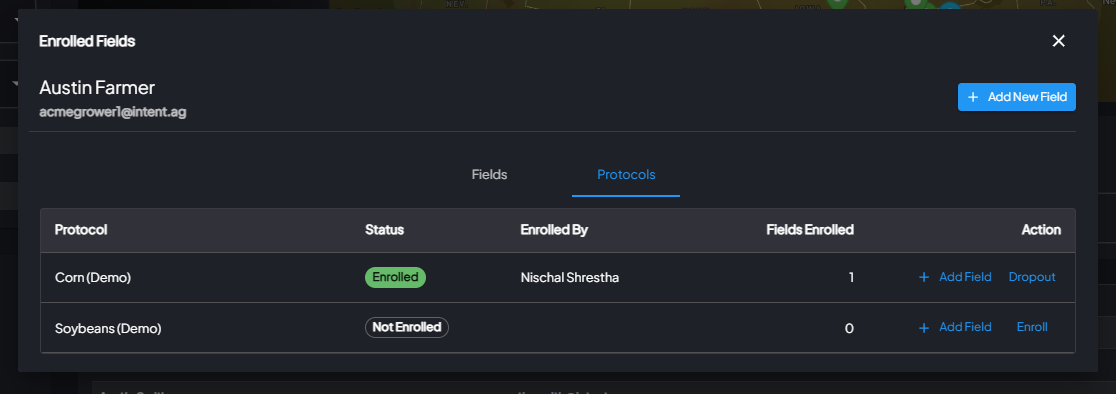March & April 2025 Release v3.8.0
INVISION v3.8.0 introduces significant new features, platform enhancements, and stability fixes across Field Operations, Trial Management, GIS Workstation, Enrollment workflows, and Exports.
New Features
1. Fields Administration – Full Control
Users with the appropriate permissions can now directly manage field data from Trials Overview & Project Management.
-
Client Admins can:
-
Rename fields within their account.
-
Reassign field ownership within their scope.
-
-
Super Admins can:
-
Rename fields.
-
Reassign ownership.
-
Edit field boundaries.
-
Delete fields (with safeguards to prevent deletion when associated data is present).
-
Value: Reduces helpdesk reliance, empowers client-admins with self-service tools, and ensures better data governance while protecting trial integrity.
2. Season Start Dates in Protocols
Protocols now allow admins to configure custom season start dates.
-
Options:
-
Default → Actual planting date.
-
Custom → Manually defined season start date.
-
-
Impacts:
-
Growing Degree Days (GDD) accumulation.
-
Field Weather timelines (Season at a Glance).
-
Imagery timelines.
-
Visit schedules.
-
🌱 Why Season Start Dates Matter
Most crops are managed by their planting date. That date drives everything downstream:
-
GDD (Growing Degree Days) accumulation → determines crop growth stage and development rate.
-
Imagery timelines → when NDVI/biomass images are available and meaningful.
-
Weather summaries (Season at a Glance) → tied to the crop’s growth window.
-
Visit scheduling → when agronomists go to the field for stand counts, tissue samples, etc.
If you only use the planting date, this works fine for spring-planted crops like corn or soybeans. But some crops don’t fit that model.
🌾 Examples of Region & Crop-Specific Needs
-
Winter Wheat / Dormancy Crops
-
Planted in the fall (Sept–Oct), but growth pauses over winter.
-
If you use planting date as the start, the system would “accumulate” GDD through the winter, even when the crop is dormant.
-
With custom start dates, an admin can set the season to begin when the crop “breaks dormancy” in spring (e.g., March 1).
-
This aligns weather, GDD, imagery, and visits with actual biological growth.
-
-
Double-Crop Systems
-
Some crops are grown in off-season windows (between harvest and next planting).
-
A farmer might plant soybean harvest in October, but the relevant growth season is late fall and early spring.
-
A custom season start ensures trial analysis reflects the right timeframe, not just the raw planting date.
-
3. Automated Trial Summary Exports
A new Automated Exports page provides a one-click export of Trial-Level Summary data.
-
Field Export: Core field, grower, location, and protocol details.
-
Yield Export: All Field Export details plus yield insights (yield, product/treatment, sample size, standard deviation, etc.).
Benefit: Standardized, repeatable data exports for client reporting and trial analysis.
Enhancements:
Enrollment & Grower Management
-
Trial-Level Grower Document Signing
-
Collect signed documents at the trial level (consent forms, agreements, trial-specific contracts).
-
Configurable as required or optional.
-
Controlled under Trials Management → Project Management settings.
-
-
Enrollment User Tracking
-
Trial Tags Requirement
-
When Field Access Management is enabled, Trial Tags are now mandatory during enrollment to enforce categorization and consistency.
-
GIS Workstation
-
Added ability to archive Zone Files and reprocess original planting/application data into new zones.
-
Improved shapefile handling:
-
Full support for multi-polygon shapefiles.
-
Accurate zone selection logic.
-
Functional buffer controls for precision in product assignments.
-
Enrollment – Field Boundary Upload
-
Optimized Township/Section/Range (TSR) boundary upload.
-
Significantly reduced load times when using TSR input.
PDF & Exports
-
Harvest PDFs updated to include photos and external links directly in the generated document.
- Boundary files are now automatically included in Protocol-Level Automated Exports.
Bug Fixes
-
Mobile – Field Visits: Fixed issue where photos were duplicated when captured during field visits.
-
Field Visit Planning: Dropout fields now correctly excluded from planning views.
-
Machine Data Setup: Resolved initialization errors for John Deere assets during setup.
-
Exports: Boundary files are now properly included in Protocol-level automated exports.
-
GIS Workstation:
-
Operation Dates “eyeball” toggle fixed to properly hide/unhide map layers.
-
Pin Tool bug resolved: pins now remain visible during selection and no longer trigger errors.
-




